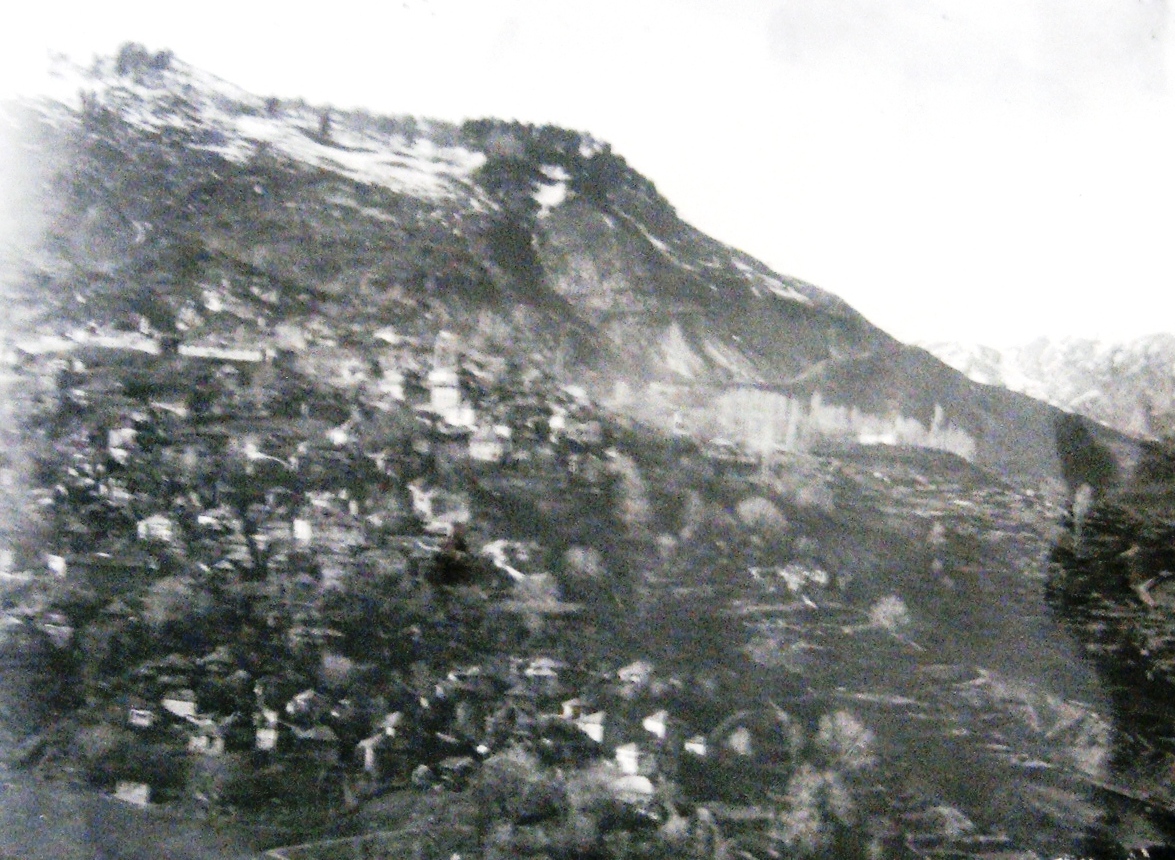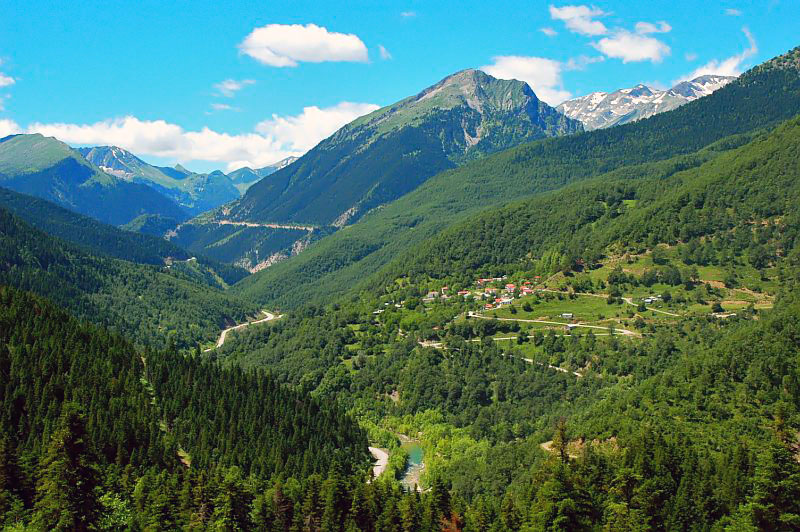|
Exarchate Of Metsovo
{{no footnotes, date=July 2014 The first available information about the ecclesiastical organization of Metsovo and its environs points to the fact that, in the 14th century, it was part of the Metropolis of Ioannina. Furthermore, there are accounts of the existence of monasteries during the same period in the area, as well as in the wider region of the central Pindos. The administrative inclusion of Metsovo in the Ottoman Sanjak of Trikala in the mid-15th century would require corresponding changes in the ecclesiastic administration, but this is not attested before the mid-17th century, when Metsovo was under the Metropolis of Stagoi. According to Aravantinos, in the 16th century the Patriarchate of Constantinople transferred the exarchate supervising the Aromanian villages in the area to the hegoumenos of the monastery of Voutsa. This testimony is evidence of the establishment of a distinct ecclesiastic Exarchate of Metsovo at the time, a development connected with the grant ... [...More Info...] [...Related Items...] OR: [Wikipedia] [Google] [Baidu] |
Metsovo
Metsovo ( el, Μέτσοβο; rup, Aminciu) is a town in Epirus, in the mountains of Pindus in northern Greece, between Ioannina to the west and Meteora to the east. The largest centre of Aromanian (Vlach) life in Greece, Metsovo is a large regional hub for several small villages and settlements in the Pindus region, and it features many shops, schools, offices, services, museums, and galleries. The economy of Metsovo is dominated by agriculture and tourism, the latter of which flourishes in winter. Metsovo is served by Greek National Road 6 (Ioannina – Trikala) and by the Egnatia Odos motorway. Etymology From medieval times till well into the 19th century, Metsovo was known, in various sources, as ''Metzovo''. From the end of the 18th century on, the literary form of ''Messovon'' makes its appearance. The town is known as ''Aminciu'' in Aromanian (Vlach), and as ''Miçova'' in Ottoman Turkish. Ottoman census records In the Ottoman census records we see the word ''Mc ... [...More Info...] [...Related Items...] OR: [Wikipedia] [Google] [Baidu] |
Metropolis Of Ioannina
The Metropolis of Ioannina ( el, Ιερά Μητρόπολις Ιωαννίνων, ''Iera Mitropolis Ioanninon'') is a Greek Orthodox diocese centred on the city of Ioannina, in the Epirus of Greece. As one of the "New Lands", it belongs formally to the Patriarchate of Constantinople, but is administered by the Church of Greece. , the Metropolitan of Ioannina is Maximos Papagiannis. History The exact time of Ioannina's foundation is unknown. It is commonly identified with an unnamed new, "well-fortified" city, recorded by the historian Procopius (''De Aedificiis'', IV.1.39–42) as having been built by the Byzantine emperor Justinian I () for the inhabitants of ancient Euroia, but archaeological evidence for this is lacking; indeed, early 21st-century excavations have brought to light fortifications dating to the Hellenistic period (4th–3rd centuries BC), the course of which was largely followed by the later Castle of Ioannina. The name Ioannina appears for the first time in 87 ... [...More Info...] [...Related Items...] OR: [Wikipedia] [Google] [Baidu] |
Pindos
The Pindus (also Pindos or Pindhos; el, Πίνδος, Píndos; sq, Pindet; rup, Pindu) is a mountain range located in Northern Greece and Southern Albania. It is roughly 160 km (100 miles) long, with a maximum elevation of 2,637 metres (8652') (Smolikas, Mount Smolikas). Because it runs along the border of Thessaly and Epirus, the Pindus range is known colloquially as the ''spine of Greece''. The mountain range stretches from near the Greek-Albanian border in southern Albania, entering the Epirus (region), Epirus and Macedonia (Greece), Macedonia regions in northern Greece down to the north of the Peloponnese. Geologically it is an extension of the Dinaric Alps, which dominate the western region of the Balkans, Balkan Peninsula. History of the name Historically, the name Pindos refers to the mountainous territory that separates the greater Epirus region from the regions of Macedonia and Thessaly. According to John Tzetzes (a 12th-century Byzantine writer), the Pindos ... [...More Info...] [...Related Items...] OR: [Wikipedia] [Google] [Baidu] |
Sanjak Of Trikala
The Sanjak of Tirhala or Trikala (Ottoman Turkish: ; el, λιβάς/σαντζάκι Τρικάλων) was second-level Ottoman province ( or ) encompassing the region of Thessaly. Its name derives from the Turkish version of the name of the town of Trikala. It was established after the conquest of Thessaly by the Ottomans led by Turahan Bey, a process which began at the end of the 14th century and ended in the mid-15th century. History In the mid-14th century, Thessaly had been ruled by Serbian and Greek lords and enjoyed great prosperity. It was conquered by the Ottoman Turks in successive waves, in 1386/7, the mid-1390s, and again after 1414/23, and the conquest was not completed until 1470. Trikala itself fell probably in 1395/6 (although Evliya Çelebi claims it happened as early as 1390). The newly conquered region was initially the patrimonial domain of the powerful marcher-lord () Turahan Bey (died 1456) and of his son Ömer Bey (died 1484) rather than a regular provin ... [...More Info...] [...Related Items...] OR: [Wikipedia] [Google] [Baidu] |
Metropolis Of Stagoi
A metropolis () is a large city or conurbation which is a significant economic, political, and cultural center for a country or region, and an important hub for regional or international connections, commerce, and communications. A big city belonging to a larger urban agglomeration, but which is not the core of that agglomeration, is not generally considered a metropolis but a part of it. The plural of the word is ''metropolises'', although the Latin plural is ''metropoles'', from the Greek ''metropoleis'' (). For urban centers outside metropolitan areas that generate a similar attraction on a smaller scale for their region, the concept of the regiopolis ("regio" for short) was introduced by urban and regional planning researchers in Germany in 2006. Etymology Metropolis (μητρόπολις) is a Greek word, coming from μήτηρ, ''mḗtēr'' meaning "mother" and πόλις, ''pólis'' meaning "city" or "town", which is how the Greek colonies of antiquity referred to ... [...More Info...] [...Related Items...] OR: [Wikipedia] [Google] [Baidu] |
Patriarchate Of Constantinople
The Ecumenical Patriarchate of Constantinople ( el, Οἰκουμενικὸν Πατριαρχεῖον Κωνσταντινουπόλεως, translit=Oikoumenikón Patriarkhíon Konstantinoupóleos, ; la, Patriarchatus Oecumenicus Constantinopolitanus; tr, Rum Ortodoks Patrikhanesi, İstanbul Ekümenik Patrikhanesi, "Roman Orthodox Patriarchate, Ecumenical Patriarchate") is one of the fifteen to seventeen autocephalous churches (or "jurisdictions") that together compose the Eastern Orthodox Church. It is headed by the Ecumenical Patriarch of Constantinople, currently Bartholomew, Archbishop of Constantinople. Because of its historical location as the capital of the former Eastern Roman (Byzantine) Empire and its role as the mother church of most modern Orthodox churches, Constantinople holds a special place of honor within Orthodoxy and serves as the seat for the Ecumenical Patriarch, who enjoys the status of ''primus inter pares'' (first among equals) among the world's ... [...More Info...] [...Related Items...] OR: [Wikipedia] [Google] [Baidu] |
Exarchate
An exarchate is any territorial jurisdiction, either secular or ecclesiastical, whose ruler is called an exarch. The term originates from the Greek word ''arkhos'', meaning a leader, ruler, or chief. Byzantine Emperor Justinian I created the first exarchates during his invasion of the former Western Roman Empire, and the term is still used for naming some of the smaller communities of Eastern Rite Catholics as well as Eastern Orthodox Christians. Administration of the secular Byzantine Empire * Exarchate of Africa * Exarchate of Ravenna Ecclesiastical administration Catholicism Apostolic exarchates in the Eastern Catholic churches * Greek Catholic Apostolic Exarchate of Greece * Greek Catholic Apostolic Exarchate of Istanbul * Apostolic Exarchate in Germany and Scandinavia for the Ukrainians * Apostolic Exarchate of Serbia (until 19 January 2013 was named Apostolic Exarchate of Serbia and Montenegro) * Apostolic Exarchate in the Czech Republic Maronite Catholic ... [...More Info...] [...Related Items...] OR: [Wikipedia] [Google] [Baidu] |
Aromanians
The Aromanians ( rup, Armãnji, Rrãmãnji) are an ethnic group native to the southern Balkans who speak Aromanian, an Eastern Romance language. They traditionally live in central and southern Albania, south-western Bulgaria, northern and central Greece and North Macedonia, and can currently be found in central and southern Albania, south-western Bulgaria, south-western North Macedonia, northern and central Greece, southern Serbia and south-eastern Romania (Northern Dobruja). An Aromanian diaspora living outside these places also exists. The Aromanians are known by several other names, such as "Vlachs" or "Macedo-Romanians" (sometimes used to also refer to the Megleno-Romanians). The term "Vlachs" is used in Greece and in other countries to refer to the Aromanians, with this term having been more widespread in the past to refer to all Romance-speaking peoples of the Balkan Peninsula and Carpathian Mountains region (Southeast Europe). Their vernacular, Aromanian, is an East ... [...More Info...] [...Related Items...] OR: [Wikipedia] [Google] [Baidu] |
Hegoumenos
Hegumen, hegumenos, or igumen ( el, ἡγούμενος, trans. ), is the title for the head of a monastery in the Eastern Orthodox and Eastern Catholic Churches, similar to the title of abbot. The head of a convent of nuns is called a hegumenia or igumeni ( el, ἡγουμένη). The term means "the one who is in charge", "the leader" in Greek. Overview Initially the title was applied to the head of any monastery. After 1874, when the Russian monasteries were reformed and classified into three classes, the title of ''hegumen'' was reserved only for the lowest, third class. The head of a monastery of the second or first class holds the rank of archimandrite. In the Greek Catholic Church, the head of all monasteries in a certain territory is called the ''protohegumen''. The duties of both hegumen and archimandrite are the same, archimandrite being considered the senior dignity of the two. In the Russian Orthodox Church the title of Hegumen may be granted as an honorary ... [...More Info...] [...Related Items...] OR: [Wikipedia] [Google] [Baidu] |
Population Exchange Between Greece And Turkey
The 1923 population exchange between Greece and Turkey ( el, Ἡ Ἀνταλλαγή, I Antallagí, ota, مبادله, Mübâdele, tr, Mübadele) stemmed from the "Convention Concerning the Exchange of Greek and Turkish Populations" signed at Lausanne, Switzerland, on 30 January 1923, by the governments of Greece and Turkey. It involved at least 1.6 million people (1,221,489 Greek Orthodox from Asia Minor, Eastern Thrace, the Pontic Alps and the Caucasus, and 355,000–400,000 Muslims from Greece), most of whom were forcibly made refugees and ''de jure'' denaturalized from their homelands. The initial request for an exchange of population came from Eleftherios Venizelos in a letter he submitted to the League of Nations on 16 October 1922, as a way to normalize relations de jure, since the majority of surviving Greek inhabitants of Turkey had fled from recent massacres to Greece by that time. Venizelos proposed a "compulsory exchange of Greek and Turkish populations," and asked ... [...More Info...] [...Related Items...] OR: [Wikipedia] [Google] [Baidu] |
Metropolis Of Grevena
A metropolis () is a large city or conurbation which is a significant economic, political, and cultural center for a country or region, and an important hub for regional or international connections, commerce, and communications. A big city belonging to a larger urban agglomeration, but which is not the core of that agglomeration, is not generally considered a metropolis but a part of it. The plural of the word is ''metropolises'', although the Latin plural is ''metropoles'', from the Greek ''metropoleis'' (). For urban centers outside metropolitan areas that generate a similar attraction on a smaller scale for their region, the concept of the regiopolis ("regio" for short) was introduced by urban and regional planning researchers in Germany in 2006. Etymology Metropolis (μητρόπολις) is a Greek word, coming from μήτηρ, ''mḗtēr'' meaning "mother" and πόλις, ''pólis'' meaning "city" or "town", which is how the Greek colonies of antiquity referred ... [...More Info...] [...Related Items...] OR: [Wikipedia] [Google] [Baidu] |





.jpg)
.jpg)